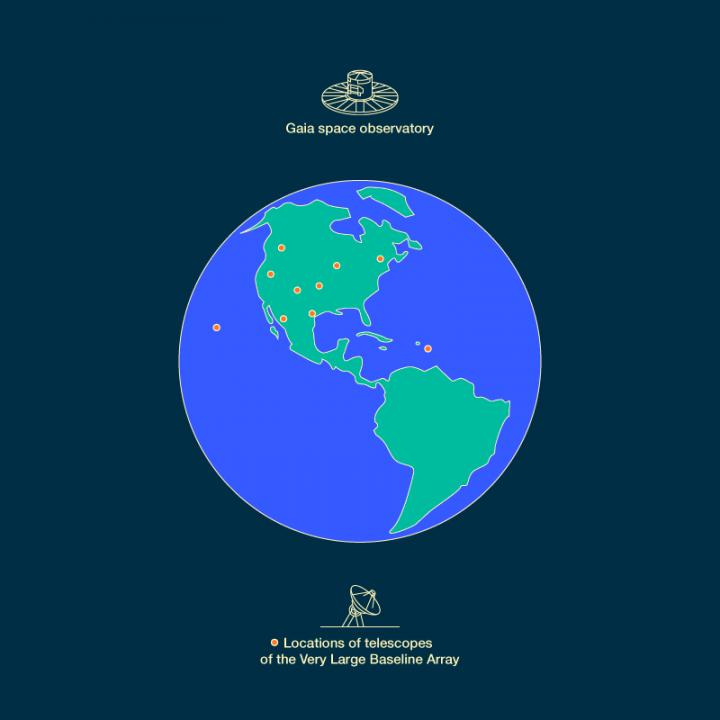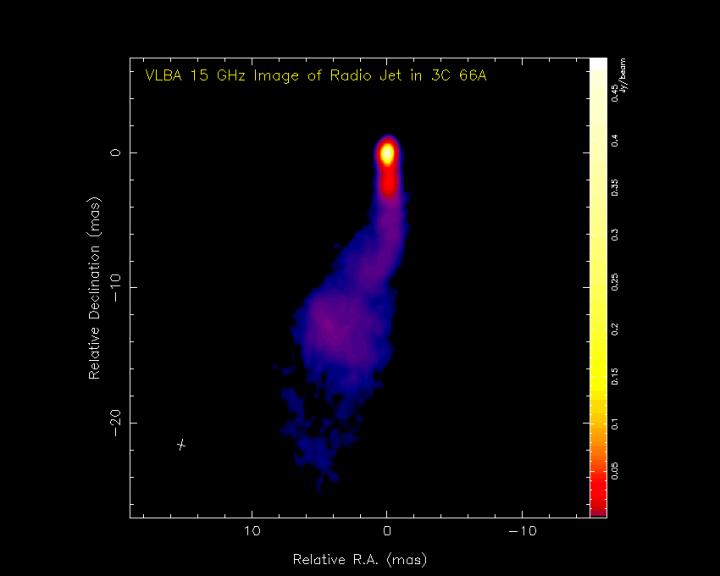
VLBI, Gaia Data Could Improve Our Understanding of Quasars
MOSCOW, Sept. 18, 2017 — An analysis of unexpected discrepancies between observations conducted by an international network of radio telescopes and observations conducted by Gaia, the space observatory of the European Space Agency, has led scientists to discover the properties of unseen "tails" sticking out of supermassive black holes at the heart of active galactic nuclei.
Physicists Yuri Kovalev and Leonid Petrov from the Moscow Institute of Physics and Technology (MIPT) and Lebedev Physical Institute (LPI) analyzed the coordinates of active nuclei of remote galaxies, obtained independently by very long baseline interferometry (VLBI) and the Gaia space astrometry observatory.
According to the scientists, the synergy of VLBI, which is sensitive to the position of the most compact source component, and Gaia, which is sensitive to the centroid of optical emission, has opened a window of opportunity to study optical jets at milliarcsecond resolution, two orders of magnitude finer than the resolution of most existing optical instruments.

Earth-based radio interferometers, such as the Very Long Baseline Array in New Mexico, enable imaging quasars and determining their coordinates with an unparalleled — up until recently — resolution of one millisecond of arc or better. The launch of Gaia by the European Space Agency could make measurements of stellar and galactic coordinates even more precise. Courtesy of MIPT Press Office.
“It is no exaggeration to say that a new area of observational astrophysics has begun,” said Kovalev. “By comparing the data from radio interferometers and optical telescopes, we can obtain information about hot jets and the accretion disks surrounding black holes at the center of galaxies in the visible part of the spectrum. We have now gained a better understanding of what their structure is and what processes occur inside them.”
Since its launch in 2013, Gaia has cataloged more than one billion objects. More than 10,000 of these are quasars, which involve matter in the form of an accretion disk falling into a massive black hole that, in turn, ejects extended beams of matter called jets. As matter falls onto the black hole, it is heated to temperatures so extreme that it starts emitting radiation across almost the entire electromagnetic spectrum.
To study such objects, VLBI has normally been employed. It involves the use of multiple radio telescopes positioned far from each other but working as an integrated system. This technique allows the angular resolution achieved by optical telescopes to be increased several hundredfold.

This image illustrates the expulsion of hot plasma in remote quasars as seen in radio waves with a resolution better than one milliarcsecond. The luminosity is reflected by the colors used, with yellow corresponding to higher and blue to lower levels. Courtesy of Y. Kovalev and the MOJAVE collaboration.
“But there are things you can't see in the radio,” said Petrov. “. . . For instance, an accretion disk around a supermassive black hole emits mostly visible and ultraviolet light. So we decided to combine the data from two sources.”
When the physicists compared the data on the coordinates of quasars obtained by Gaia and VLBI, they found that for about six percent of objects, the positions did not agree. Generally, they found that the position of an object provided by Gaia was shifted in the direction of jets.
“We can now use the data on variable radiation output and position of quasars provided by radio interferometry and Gaia to recreate and study the structure of hundreds of very remote quasars at the scale of parsecs, thousandths of a second of arc. This precision is superior to what is possible with ordinary optical telescopes and even with Hubble,” said Kovalev.
He added that data analysis revealed the existence of bright jets emitting in visible light in many quasars at angular scales so fine that even the Hubble Space Telescope could not detect them. In order to see such a structure directly, a space telescope with a mirror the size of a stadium would be needed. The scientists suggested a method for revealing this structure indirectly by combining the data from existing telescopes.
The investigation of variations in source positions and brightness could advance understanding of the physics of accretion disks and supermassive black holes. The comparison of the data provided by VLBI and the Gaia space telescope indicated the presence of a certain source position "jitter" in the optical range, a discovery that could lead to more judicious use of VLBI-based quasar observations for tracking the movement of continents and operating positioning systems, including GPS and GLONASS.
The research was published in Monthly Notices of the Royal Astronomical Society (doi: 10.1093/mnras/stx1747).
Published: September 2017